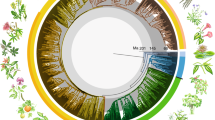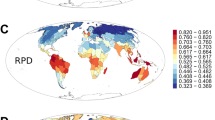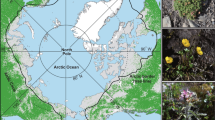Abstract
Although the pattern of the early angiosperm radiation has been substantially clarified by palaeobotanical and stratigraphic investigations over the last 30 years1–3, knowledge of associated vegetational and floristic change remains limited. Quantitative analyses of Cretaceous fossil floras indicate that by ∼90 million years before present (BP) angiosperms had achieved widespread floristic dominance, at least in the Northern Hemisphere. Although some non-angiosperm plant groups show no pronounced shifts in diversity in association with the angiosperm radiation, others show marked declines that contribute to profound alterations in the composition of terrestrial plant communities. Comparative trends in systematic diversity suggest competitive displacement of cycadophytes and pteridophytes by angiosperms, but current evidence is not sufficient to exclude the probability of a more complex basis for mid-Cretaceous floristic change.
This is a preview of subscription content, access via your institution
Access options
Subscribe to this journal
Receive 51 print issues and online access
$199.00 per year
only $3.90 per issue
Buy this article
- Purchase on Springer Link
- Instant access to full article PDF
Prices may be subject to local taxes which are calculated during checkout
Similar content being viewed by others
References
Doyle, J. A. A. Rev. Ecol. Syst. 9, 365–392 (1978).
Hickey, L. J. & Doyle, J. A. Bot. Rev. 43, 3–104 (1977).
Friis, E. M., Chaloner, W. G. & Crane, P. R. (eds) The Origins of Angiosperms and their Biological Consequences (Cambridge University Press, 1987).
Muller, J. Bot. Rev. 47, 1–142 (1981).
Muller, J. Ann. Mo. bot. Gdn 71, 419–443 (1984).
Niklas, K. J., Tiffney, B. H. & Knoll, A. H. Nature 303, 614–616 (1983).
Niklas, K. J., Tiffney, B. H. & Knoll, A. H. in Phanerozoic Diversity Patterns: Profiles in Macroevolution (ed. Valentine, J. W.) 97–128 (Princeton University Press, 1985).
Niklas, K. J., Tiffney, B. H. & Knoll, A. H. in Evolutionary Biology Vol. 12 (eds Hecht, M. K., Steere, W. C. & Wallace, B.) 1–89 (Plenum, New York, 1980).
Tiffney, B. H. in Paleobotany, Paleoecology and Evolution Vol. 2 (ed. Niklas, K. J.) 193–230 (Praeger, New York, 1981).
Knoll, A. H. in Extinctions (ed. Nitecki, M. H.) 21–68 (University of Chicago Press, 1984).
Knoll, A. H. in Community Ecology (eds Diamond, J. & Case, T. J.) 126–141 (Harper & Row, New York, 1986).
Crane, P. R. in The Origins of Angiosperms and their Biological Consequences (eds Friis, E. M., Chaloner, W. G. & Crane, P. R.) 107–144 (Cambridge University Press, 1987).
Koch, C. F. Paleobiology 4, 367–372 (1978).
Ferguson, D. K. Rev. Palaeobot. Palynol. 46, 117–188 (1985).
Signor, P. R. & Lipps, J. H. Spec. Pap. geol. Soc. Am. 190, 291–295 (1982).
Hughes, N. F. Bot. Rev. 43, 105–127 (1977).
Bell, W. A. Bull. geol. Surv. Can. 13, 1–231 (1949).
Bell, W. A. Mem. geol. Surv. Can. 285, 1–331 (1956).
Bell, W. A. Mem. geol. Surv. Can. 293, 1–84 (1957).
Bell, W. A. Bull. geol. Surv. Can. 94, 1–76 (1963).
Kitchell, J.A. Paleobiology 11, 91–104 (1985).
Crane, P. R. & Upchurch, G. R. Am. J. Bot. 74, 1722–1736 (1987).
Kemper, E. Geol. Jb. A 96, 5–185 (1987).
Dilcher, D. L. & Crane, P. R. Ann. Mo. bot. Gdn 71, 351–383 (1984).
Walker, J. W., Brenner, G. J. & Walker, A. G. Science 220, 1273–1275 (1983).
Crane, P. R., Friis, E. M. & Pedersen, K. R. Science 232, 852–854 (1986).
Walker, J. W. & Walker, A. G. Ann. Mo. bot. Gdn 7l, 464–521 (1984).
Friis, E. M., Crane, P. R. & Pedersen, K. R. Nature 320, 163–164 (1986).
Crane, P. R. Pl. Syst. Ecol. (in the press)
Hughes, N. F. & McDougall, A. B. Reo. Palaeobot. Palynol. 50, 255–272 (1986).
Sepkoski, J. I. Paleobiology 4, 223–251 (1978).
Knoll, A. H., Niklas, K. J., Gensei, P. G. & Tiffney, B. H. Paleobiology 10, 34–47 (1984).
Harland, W. B. et al. A Geologie Time Scale (Cambridge University Press, 1982).
Lesquereux, L. Monogr. U. S. geol Sun. 17, 1–400 (1892).
Author information
Authors and Affiliations
Rights and permissions
About this article
Cite this article
Lidgard, S., Crane, P. Quantitative analyses of the early angiosperm radiation. Nature 331, 344–346 (1988). https://doi.org/10.1038/331344a0
Received:
Accepted:
Issue Date:
DOI: https://doi.org/10.1038/331344a0
This article is cited by
-
The angiosperm radiation played a dual role in the diversification of insects and insect pollinators
Nature Communications (2024)
-
Nitrogen isotopes reveal independent origins of N2-fixing symbiosis in extant cycad lineages
Nature Ecology & Evolution (2023)
-
Fluctuation in the diversity of mayflies (Insecta, Ephemerida) as documented in the fossil record
Scientific Reports (2023)
-
Climate windows of opportunity for plant expansion during the Phanerozoic
Nature Communications (2022)
-
Limits to reproduction and seed size-number trade-offs that shape forest dominance and future recovery
Nature Communications (2022)
Comments
By submitting a comment you agree to abide by our Terms and Community Guidelines. If you find something abusive or that does not comply with our terms or guidelines please flag it as inappropriate.



